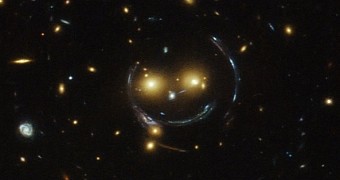Of all the places anyone would ever imagine encountering a smiley face, outer space is probably last on the list. Still, it looks like the cosmos does have a sense of humor and isn't just about supernovas and churning clouds of gas and dust.
Not to beat about the bush, it was this past Monday that astronomers released a brand new space image showing what appears to be a glowing smiley face floating about in space. The image, available next to this article, was taken with the Hubble Space Telescope.
What this space emoticon really is
Scientists with the European Space Agency say that this latest Hubble Space Telescope image shows a galaxy cluster dubbed SDSS J1038+4849. This cluster is located at a distance of about 4.5 billion light-years from our planet and comprises trillions of stars.
The smiley face's two orange eyes, together with its white button nose, are galaxies. The somewhat bigger ones that stand in the place of the eyes are elliptical ones. As noticeable, the galaxy that forms the nose is considerably smaller than these two.
The reason this cosmic face comes complete with a contour and a great, big smile is an effect known to the scientific community as strong gravitational lensing. Thus, scientists say that it was this effect that birthed the arcs visible in the image.
OK, so what's the deal with this effect?
As explained by astronomers with the European Space Agency, galaxy clusters like SDSS J1038+4849 are the absolute biggest structures in the cosmos. Being as big as they are, they exert insanely powerful gravitational pulls.
Apart from distorting the path of objects traveling through the universe, these gravitational pulls can warp space itself. In the case of galaxy clusters, the resulting distortions are serious enough to bend light. Otherwise put, their strong gravity turns galaxy clusters into cosmic lenses.
“Galaxy clusters are the most massive structures in the universe and exert such a powerful gravitational pull that they warp the space-time around them and act as cosmic lenses which can magnify, distort and bend the light behind them,” scientists say.
What this means is that the arcs that complete the Hubble Space Telescope image of the cosmic smiley face are actually light that the galaxy cluster's strong gravitational pull managed to distort and bend.

 14 DAY TRIAL //
14 DAY TRIAL //